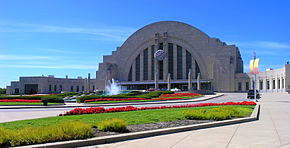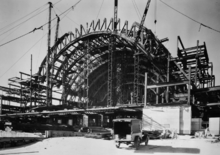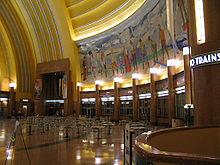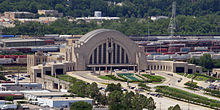Cincinnati Museum Center at Union Terminal

Cincinnati Union Terminal – Those Were the Days
Video on the history and development of Cincinnati Museum Center and the remarkable story of saving Union Terminal.
 The Cincinnati Museum Center at Union Terminal, originally Cincinnati Union Terminal, is a passenger railroad station in the Queensgate neighborhood of Cincinnati, Ohio, United States. After the decline of railroad travel, most of the building was converted to other uses, and now houses museums, theaters, and a library.
The Cincinnati Museum Center at Union Terminal, originally Cincinnati Union Terminal, is a passenger railroad station in the Queensgate neighborhood of Cincinnati, Ohio, United States. After the decline of railroad travel, most of the building was converted to other uses, and now houses museums, theaters, and a library.
Background
Cincinnati was a major center of railroad traffic in the late 19th and early 20th century, especially as an interchange point between railroads serving the Northeastern and Midwestern states with railroads serving the South. However, intercity passenger traffic was split among no fewer than five stations in Downtown Cincinnati, requiring the many travelers who changed between railroads to navigate local transit themselves. The Louisville and Nashville Railroad, which operated through sleepers with other railroads, was forced to split its operations between two stations. Proposals to construct a union station began as early as the 1890s, and a committee of railroad executives formed in 1912 to begin formal studies on the subject, but a final agreement between all seven railroads that served Cincinnati and the city itself would not come until 1928, after intense lobbying and negotiations, led by Philip Carey Company president George Crabbs. The seven railroads: the Baltimore and Ohio Railroad; the Chesapeake and Ohio Railroad; the Cleveland, Cincinnati, Chicago and St. Louis Railway; the Louisville and Nashville Railroad; the Norfolk and Western Railway; the Pennsylvania Railroad; and the Southern Railway selected a site for their new station in theWest End, near the Mill Creek.
 Structural framing of the dome during construction
Structural framing of the dome during construction
Architecture and design
The principal architects of the massive building were Alfred T. Fellheimer and Steward Wagner, with architects Paul Philippe Cret and Roland Wank brought in as design consultants; Cret is often credited as the building’s architect, as he was responsible for the building’s signature Art Deco style. The Rotunda features the largest semi-dome in the western hemisphere, measuring 180 feet wide and 106 feet high.
The Murals
German American artist Winold Reiss was commissioned to design and create two 22 foot (6.7 m) high by 110 foot (33.5 m) long color mosaic murals depicting the history of Cincinnati for the rotunda, two murals for the baggage lobby, two murals for the departing and arriving train boards, 14 smaller murals for the train concourse representing local industries and the large world map mural located at the rear of the concourse. Reiss spent roughly two years in the design and creation of the murals. The murals located in the train concourse were removed when the concourse building was demolished in the 1970s. The murals removed from the train concourse were then placed on display at the Cincinnati/Northern Kentucky International Airport. The 14 industry murals chosen for the railroad concourse include:
 View of one mural in the rotunda of the Cincinnati Museum Center.
View of one mural in the rotunda of the Cincinnati Museum Center.
- Piano making (Baldwin Piano Company)
- Radio broadcasting (Crosley Broadcasting Corporation)
- Roof manufacture (Philip Carey Co.)
- Tanning (American Oak Leather Co.)
- Airplane and parts manufacture (Aeronca Aircraft Company)
- Ink making (Ault & Weiborg Corp.)
- Laundry-machinery manufacture (American Laundry Machine)
- Meat packing (Kahn’s Meat Packing)
- Drug and chemical processing (William S. Merrill Co.)
- Printing and publishing (U.S. Playing Card Co. and Champion Paper Company)
- Foundry products operations (Cincinnati Milling Machine)
- Sheet steel making (American Rolling Mills and Newport Rolling Mill)
- Soap making (The Procter & Gamble Co.)
- Machine tools manufacture (Cincinnati Milling Machine).
Pierre Bourdelle, son of renowned French sculptor Antoine Bourdelle, also created commissioned artwork for the terminal, including a Jungle-themed mural for the Women’s Lounge.
The Union Terminal Company was created to build the terminal itself, the railroad lines into and out of the terminal, and other related transportation improvements. Construction and improvements began in 1928 with the regrading of the east flood plain of the Mill Creek to a point nearly level with the surrounding city, a massive effort that required 5.5 million cubic yards of landfill. Other improvements included the construction of grade separated viaducts over the Mill Creek and the railroad approaches to Union Terminal. The new viaducts the Union Terminal Company created to cross the Mill Creek valley ranged from the well built, like the Western Hills Viaduct, to the more hastily constructed and shabby, like the Waldvogel Viaduct. Construction on the terminal building itself began in 1931, with Cincinnati mayor Russell Wilson laying the mortar for the cornerstone. Construction was finished ahead of schedule, although the terminal welcomed its first trains even earlier on March 19, 1933 when it was forced into emergency operation due to flooding of the Ohio River. The official opening of the station was on March 31, 1933. The total cost of the project was $41.5 million.
Operation
 Trains are seen here, behind Union Terminal.
Trains are seen here, behind Union Terminal.
During its heyday as a passenger rail facility, Union Terminal had a capacity of 216 trains per day, 108 in and 108 out. Three concentric lanes of traffic were included in the design of the building, underneath the main rotunda of the building: one for taxis, one for buses, and one (although never used) for streetcars. However, the time period in which the terminal was built was one of decline for train travel. By 1939, local newspapers were already describing the station as a white elephant. While it had a brief revival in the 1940s, because of World War II, it declined in use through the 1950’s and the 1960s. In July 1958, Union Terminal was witness to the end of an era as the last mainline passenger steam train in the United States, the Norfolk and Western No. 603, originated in Cincinnati.
 In 1971, after the creation of Amtrak, train service at Union Terminal was reduced to just two trains a day, the George Washington and the James Whitcomb Riley. Amtrak abandoned Union Terminal the next year, opening a smaller station elsewhere in Cincinnati on October 29, 1972.
In 1971, after the creation of Amtrak, train service at Union Terminal was reduced to just two trains a day, the George Washington and the James Whitcomb Riley. Amtrak abandoned Union Terminal the next year, opening a smaller station elsewhere in Cincinnati on October 29, 1972.
http://en.wikipedia.org/wiki/Cincinnati_Museum_Center_at_Union_Terminal


